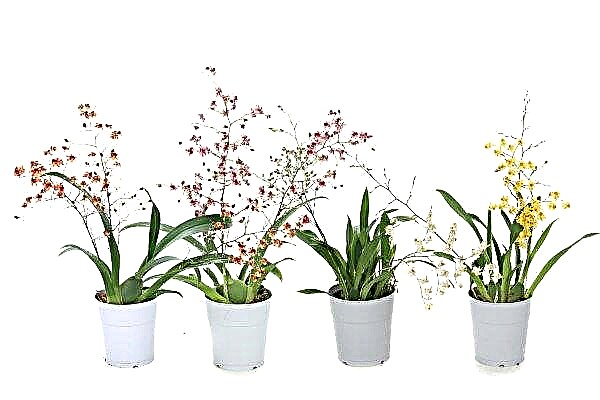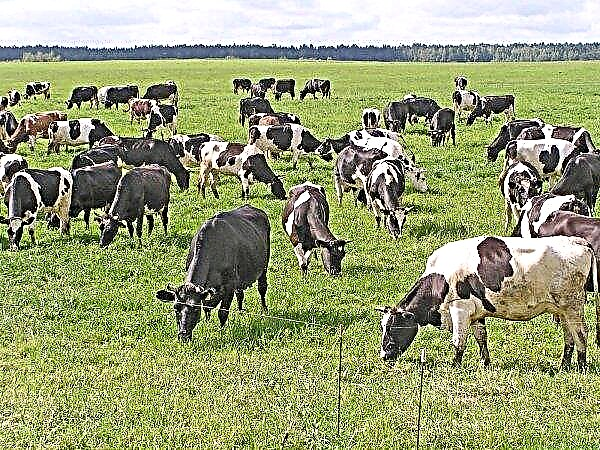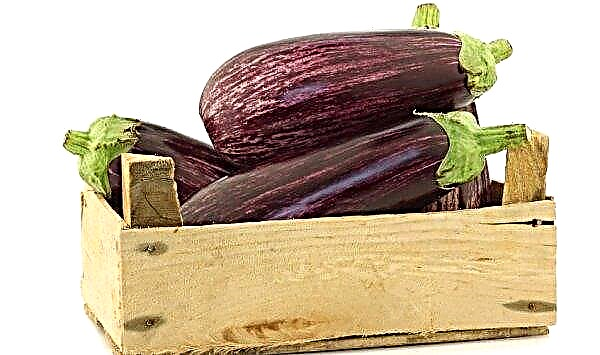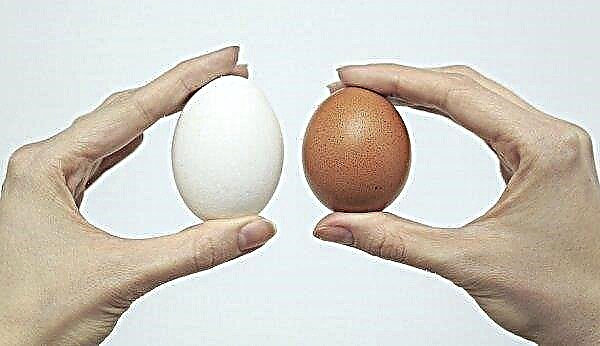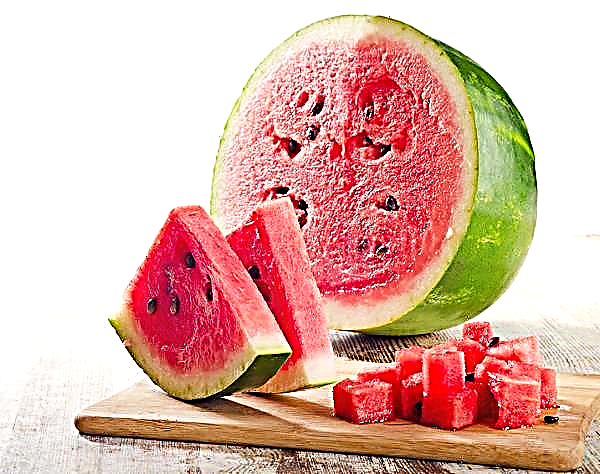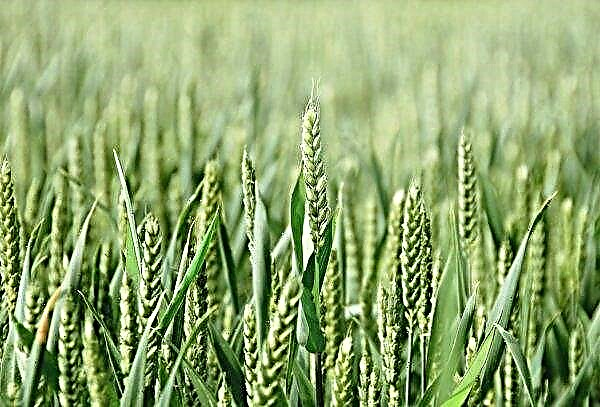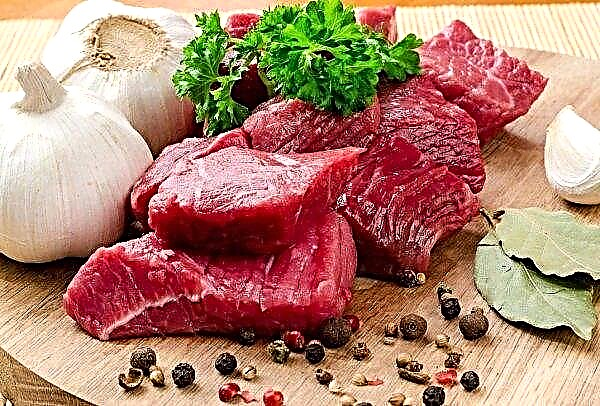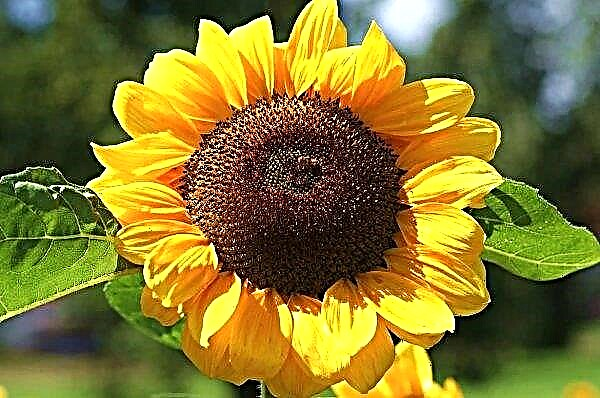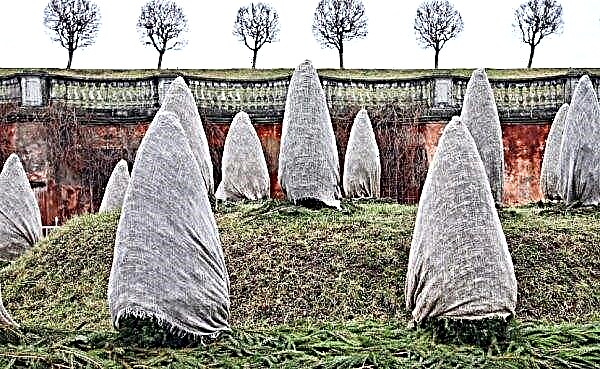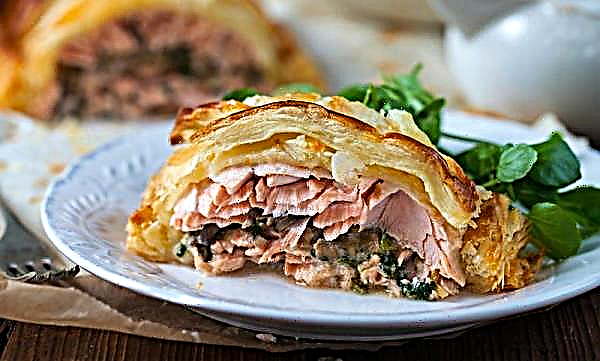Every year, farmers harvest for the future many fruit crops, among which cabbage is one of the first places. Today, many varieties of vegetables are known, but not all of them really can boast of productivity and high quality of the crop. This article describes in detail the features of Kharkiv winter cabbage cultivars, and also describes all the subtleties of its cultivation.
Variety breeding history
Kharkov winter cabbage belongs to the high-yielding varieties of Ukrainian selection. A hybrid was bred for a long time - in the mid-70s of the XX century, by direct crossbreeding of varieties Amager 611 and Dauerweis. Its authors were scientists from the Institute of Horticulture and Melon Growing (Kharkov region, the village of Selection).
A plant is grown for growing in the temperate zone of Ukraine, but it can be grown in almost any climatic zone, with the exception of the Far Eastern and Siberian regions.
Description and characteristic
Kharkov winter is a representative of high-yielding hybrids of white cabbage. The plant has both typical characteristics of the representative of cruciferous, and its own distinctive features.
Description of heads of cabbage
This type of cabbage during the growing season forms large and dense heads of cabbage with a diameter of 30–40 cm. In the phase of technical ripeness, the mass of each of them is 3.5–4 kg. The shape of the forks is round, spherical, sometimes can be slightly flattened. The leaves are adjacent to each other tightly, the head of cabbage is divided hard. The head of the rosette is quite large, its average diameter is in the range of 80-110 cm. The color of the leaves is mostly green or pale green, a slight waxy coating appears on top of the main color.
In the section, cabbage has a white or cream shade, quite dense, not juicy. In the middle of the head of cabbage there is a stump 10–20 cm long, of medium density. The inner part practically does not contain coarse and dense veins, which makes the leaves soft and tender. The taste of the crop is saturated, typical for representatives of white-hybrids with a distinct sweetish aftertaste. During processing and grinding, the pulp gives a large amount of juice.
Did you know? For the first time, cabbage was cultivated about 4 thousand years ago. The natural habitat of this plant is considered the Mediterranean territory of Africa and Europe, from where the vegetable has spread throughout the world.
This cabbage is characterized by a high content of such beneficial substances:
- cellulose;
- vitamin C;
- potassium, zinc and sulfur.

Ripening dates
This plant belongs to late-ripening vegetable crops. About 150-170 days pass from sowing seeds to seedlings to harvesting mature heads of cabbage.
Frost resistance varieties
The hybrid has a fairly high frost resistance. Despite the fact that this cabbage requires a lot of heat for growth and fruiting, seedlings are able to successfully withstand short-term frosts up to –2 ° С.
Average yield
Kharkov winter is also distinguished by increased productivity. Subject to agricultural cultivation techniques, the average yield of a variety is about 10 kg / m². Under optimal conditions, the indicator can increase up to 15 kg / m².
Pros and cons of the variety
- The main advantages of this cabbage hybrid are the following:
- good storage and transportability;
- large sizes of heads of cabbage;
- drought tolerance and unpretentiousness;
- resistance to characteristic infections;
- resistance to cracking of mature heads of cabbage;
- crop versatility - the vegetable is suitable for fresh consumption, as well as all kinds of processing;
- cabbage does not deteriorate at a late harvest.
There were no serious shortcomings in the Kharkov winter. The only exception is the variety's need for painstaking care.
Growing seedlings
Despite the unpretentiousness and resistance of this cabbage to cold weather, its cultivation is classified as labor-intensive agrotechnical procedures. The plant requires comprehensive care, as well as daily attention throughout the season - otherwise the heads of cabbage will not be able to fully mature, and their quality will not reach the average norm.
Did you know? Cabbage was one of the main medicinal plants used by the famous ancient physician Hippocrates. Its leaves and all kinds of extracts from it were used to combat and prevent a whole range of ailments, as well as as the main means to maintain vitality.
The timing
The optimal time for planting varieties for seedlings is approximately 50 days before the expected date of planting of young plants in open soil. In the temperate zone, the beginning of April is considered the best time for this. This makes it possible at the time of transplanting seedlings to get active and healthy plants.
Soil selection and preparation
Cabbage loves fertile and loose soils, with a moderate ratio of organic and mineral substances, differing in a neutral pH value (6.5–7). Specialized substrates from garden shops are best suited for this. You can also prepare the soil yourself, for this you should mix peat, river sand and turf in equal parts.
In the resulting mixture of 10 liters, be sure to add 1 tbsp. spoon dolomite flour and superphosphate, as well as 2 tbsp. tablespoons of wood ash. Prepare the soil in advance, as it requires sterilization.
The procedure is carried out a week before sowing seeds, for this, the soil to choose from is necessary:
- fry in the oven at + 125 ° С for 25 minutes;
- soak with a 2% solution of potassium permanganate;
- keep in the freezer at –25 ° С for about 3 days.
 Soil calcination in the oven.
Soil calcination in the oven.Seed treatment before sowing
Seeds also need preparation, otherwise there is a danger of damage to the young shoots by bacterial, viral or fungal infections. To do this, the seed is optionally soaked in 70% alcohol (5-10 minutes) or in a 2% solution of potassium permanganate (30 minutes).
Before planting, seeds need to be activated. To do this, they are dipped for 20 minutes in warm water with a temperature of about + 50 ° C, and then laid out on a saucer and covered with a thin natural fabric in 1 layer. After this, the seeds should be kept in the refrigerator at a temperature of about + 5 ° C for 12 hours.
Soaking seeds in special growth stimulants will also help to improve seed germination. To do this, the seeds are additionally dipped in a solution of the drug "Humate sodium" or "Ideal" (optional). Perform the procedure for 12 hours at room temperature. To prepare the working fluid, 1 teaspoon of the product is dissolved in 1 liter of water. Calibration is an important process for selecting large germinating seeds. Soak them in 5% sodium chloride solution for 5 minutes. Those that will not sprout will emerge.
Calibration is an important process for selecting large germinating seeds. Soak them in 5% sodium chloride solution for 5 minutes. Those that will not sprout will emerge.
Seedling Care
For crops it is necessary to create standard conditions for care:
- Keep containers in a well-lit and warm place at a temperature of +22 ... + 25 ° С.
- Water seedlings sparingly and regularly. To bring water in small portions, preventing waterlogging and drying of the substrate.
- Feed crops twice: first after full germination, then repeat after 2 weeks. For feeding, a concentrated solution of cow manure (1: 4) is best suited.
- Capacities must be highlighted - daylight hours should be at least 12 hours a day.
Important! 1 week before transplanting, watering seedlings should be stopped - this will improve the rooting of cabbage in a new substrate.
Transplanting seedlings to a permanent place
The main stage in the cultivation of cabbage is the transplantation of young seedlings in the garden. The quality and rooting of cabbage depends on the correctness and sequence of all operations during this period.
Transplant Dates
The landing of the Kharkov winter in the garden, depending on the sowing date, is carried out from mid to late May. At this point, steady warm weather should come, and seedlings - give at least 5 leaves.
Seat selection
The best soil for growing vegetables are considered substrates with high or medium moisture capacity. Areas with well-fertilized loamy soils with a neutral pH are ideal for this. In their absence, the soil must be prepared, for this, 3 buckets of sand, 1 bucket of humus, 1 kg of dolomite flour or chalk should be added to 1 m² of land.
Important! It is best to grow cabbage after tomatoes, carrots or peas. Any cruciferous representatives, including turnips and radishes, are considered to be bad predecessors.
The territory of the beds should be located on a hill or plain. It is not recommended to plant cabbage in the lowland - this will lead to increased humidity in the beds and the appearance of putrefactive lesions. Also, the plant does not tolerate prolonged exposure to direct sunlight, so the beds are best placed in partial shade. Ideal for this is the neighborhood with tall vegetation, garden buildings.
Scheme and depth of landing
Cabbage seedlings are planted in a row-wise way, with a row spacing of 60–70 cm and a distance between adjacent plants in a row of about 35–40 cm. In this case, the planting depth should be within 5–10 cm. Scheme of planting cabbage. If the vegetable is grown in an open and well-lit area, every 5-10 rows must be planted tall crops, creating a moderate shade. Best suited for this is corn or sunflower.
Scheme of planting cabbage. If the vegetable is grown in an open and well-lit area, every 5-10 rows must be planted tall crops, creating a moderate shade. Best suited for this is corn or sunflower.
Landing care
Kharkov winter cabbage requires the usual care measures throughout the entire vegetative period. They provide for timely pest control, watering, fertilizing and tillage.
Watering and fertilizer
Sprinkle cabbage every 5-6 days, f in dry and hot weather, the multiplicity of the procedure is increased. Water must be purified and warmed to ambient temperature. The first 2-3 days, the irrigation rate should be about 6 l / m², then gradually increase it to 10-12 l / m².
In addition to watering, during the entire growing season, cabbage requires up to 4 top dressings:
- First time - 2 weeks after planting. Solutions of cow manure (0.5 l of manure / 10 l of water) are best suited for this, with a flow rate of 0.5 l per 1 plant.
- Next feeding - 4 weeks after planting cabbage. For this, a solution of 0.5 l of manure per 10 l of water is also used, at the rate of 0.5 l per plant.
- Third time beds are fed after 6 weeks with saturated phosphorus fertilizers. For this, 10 tbsp of water are bred 1 tbsp. a spoon of nitrophoska. The flow rate of the working fluid is 6–8 l / m².
- Last feeding - on the 9th week after planting seedlings in open soil. For this, a solution of nitrophoska or cow manure is used.
Soil care
Weeding and loosening are considered mandatory when caring for cabbage plantings. They allow you to saturate the substrate with oxygen, and also to avoid exposure to weeds cabbage. They often carry out both procedures together, which simplifies the general care of the beds. Soil must be completely loosened to a depth of about 5-7 cm, while weeds and their residues are removed from the soil.
The multiplicity of the procedure depends on watering, as weeding is done the next day after wetting the site, but at least 1 time per week. Hilling cabbage is not a mandatory measure, however, this procedure helps protect plants from pests, as well as to avoid heading during heading. Hilling is done twice, on the 10th and on the 40-50th day after planting, in dry and calm weather. Late evening is best suited for this, which helps to avoid drying out of the substrate. Hilling is performed so as to pull under the stem of the bush the maximum amount of soil in a radius of 20-30 cm around each trunk. At the same time, around the cabbage you need to form a rounded hill about 30 cm high.
Hilling is done twice, on the 10th and on the 40-50th day after planting, in dry and calm weather. Late evening is best suited for this, which helps to avoid drying out of the substrate. Hilling is performed so as to pull under the stem of the bush the maximum amount of soil in a radius of 20-30 cm around each trunk. At the same time, around the cabbage you need to form a rounded hill about 30 cm high.
Pest and Disease Control
Kharkov winter is characterized by increased resistance to major cruciferous infections, including bacterioses and necrosis, so this problem rarely occurs. To combat a variety of ailments, complex protective agents are used.
The drugs proved to be the best:
- Fitoverm;
- Inta-Vir;
- "Decis";
- "Spark".
Powerful contact preparations will save from all kinds of pests on the site.
Did you know? Cabbage fell into the territory of Russia in the 5th century, and the Greek colonies of the Black Sea region became the center of its spread.
Today, a large selection of such tools is presented on the market, but the most effective are:
- “Herald”, “Aliot”, “Sharpei”, “Senpai” - against caterpillars, aphids, cabbage fleas;
- "Fly-eater", "Terradox" - eliminate cabbage fly and its larvae;
- Miura - the best protective agent against cereal weeds.
The main threat of cabbage plantations are slugs. They like to live in the cool and humid corners of the plot, which are just the best place to grow vegetables. Overcoming slugs is not easy, as they instantly infect cabbage and quite often, eating its leaves, lead to the death of plantations, especially in the early stages of development. Slug on cabbage. The best remedy for these pests is a mixture of equal parts of sodium chloride, ground black pepper and mustard powder. The territory of the beds is abundantly sprinkled with it, as well as the nearby territory.
Slug on cabbage. The best remedy for these pests is a mixture of equal parts of sodium chloride, ground black pepper and mustard powder. The territory of the beds is abundantly sprinkled with it, as well as the nearby territory.
Harvest dates and storage
Harvesting Kharkov winter cabbage is carried out on the 150-170th day after sowing plants for seedlings. In the temperate climate zone, this period lasts from mid-September to the second half of October. However, heads of cabbage can be safely stored on the site until the first frosts, and it is recommended that vegetables be harvested before the air temperature drops below –2 ° C.
Harvested must be cleaned of the stem and the upper ball of leaves, and then stored in a special vegetable store or cellar. In this case, the vegetable should create an optimal microclimate: a temperature of about 0 ... + 2 ° C and humidity in the range of 85–95%. The storage place must necessarily be well ventilated, otherwise heads of cabbage can infect a variety of fungi. Cabbage grown on land that is excessively fertilized with nitrogen fertilizers is not suitable for storage! In the tissues of its leaves, the amount of dry matter decreases sharply, as a result, heads of cabbage become loose, quickly rot and deteriorate.
Cabbage grown on land that is excessively fertilized with nitrogen fertilizers is not suitable for storage! In the tissues of its leaves, the amount of dry matter decreases sharply, as a result, heads of cabbage become loose, quickly rot and deteriorate.
There are several ways to bookmark a vegetable for storage:
- on shelves - cabbage is placed on special stationary structures;
- in drawers - the vegetable is put in wooden or plastic boxes in several layers;
- using a clay hat - pure clay is bred to a creamy state, and then the surface of the vegetable is coated with it;
- in sand - heads are placed in deep containers, and then covered with clean sand.
Kharkov winter is a cabbage that ideally combines all the best production and taste. This variety is distinguished by good keeping quality, and its harvest is suitable for any culinary processing, including the preparation of pickles. It is not difficult to get productive vegetable beds, for this it is only necessary to take care of the plantings in a timely and regular manner.

